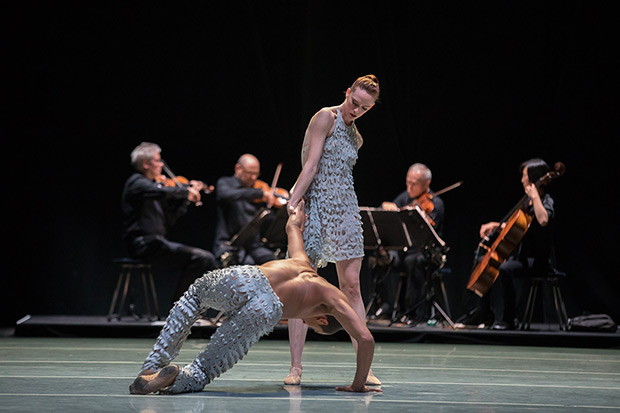
© Chris Hardy. (Click image for larger version)
Alonzo King LINES Ballet
Handel, Common Ground
★★★★✰
San Francisco, Yerba Buena Center for the Arts
7 October 2018
linesballet.org
www.ybca.org
For those dance fans who are also music devotees, Alonzo King LINES Ballet’s current program, running until October 14th at Yerba Buena Center for the Arts, is a must see. Part of LINES’ thirty-fifth anniversary season, the double bill of Handel and Common Ground provided remarkable insight into the connection between movement and sound. It was a much deeper experience than just having inspiring choreography and music in the same place at the same time, though that was indeed true. Both pieces allowed the two artistic disciplines to be in dialogue with neither entity taking control. The music wasn’t there as an accompaniment to the dance nor was the dance there to serve as a physical interpretation of the score. They were equal contributors to the conversation. Strong collaborative rigor is not only a delight to witness, it really is a privilege.
If you find music and dance’s form and structure intriguing (like I do), then Handel is for you. Choreographed in 2005 by Founder/Artistic Director Alonzo King, Handel not only turns its eye to composer George Frederic Handel but also to the Baroque musical era (1600-1750, according to most scholars). While selections from the composer’s oeuvre played over nine segments, Handel took a choreographic dive into characteristics of Baroque compositions. Most prominent was fugal counterpoint, where one or more independent ideas (voices, musical lines and in this case, bodies) unfold within the same container. King hit it out of the park with Handel. Even the fact that the dance was performed to recorded music couldn’t contain the compositional prowess.
A number of Handel’s chapters began in silence – the company artists would introduce a choreographic idea and the score would join a phrase or two later. This is exactly what happens in a fugue. A short theme is introduced on its own and then another idea enters the scene as a response or countersubject. It was a brilliant and innovative way to bring the fugal form to life on stage. As the ballet continued, so did the simultaneous independence and interdependence between the movement and the score. Sometimes two dissimilar ideas co-existed: delicate musical passages paired with angular, wretching physicality. Sometimes the choreography and the score were quite alike. Arching musical phrases mirrored by a similar rainbow effect in the body – legs fouetté-ing from front to back, over and over again. Handel was a compositional triumph, though the dancers seemed to be struggling a bit at Sunday afternoon’s matinee. The odd number of balance problems and folks slipping made me wonder if something was going on with the stage surface.

© Chris Hardy. (Click image for larger version)
If there was a problem with the stage, it was obviously dealt with during intermission. Because as we came to the centerpiece of the program, Common Ground, the highly anticipated collaboration between King and the legendary Kronos Quartet, there wasn’t a stability issue in sight. Ground did not disappoint. Performed by the full company (I think, the program wasn’t totally clear) and Kronos’ heady combination of violin, viola, cello and body percussion, Ground transported its audience to an underwater ecosystem.
Ground began with a water scene projected onto the scrim. Waves lapped, birds flew overhead and ocean sounds permeated the space. Unhurried, the scrim rose, welcoming us to the world beneath the water’s surface. Water imagery abounded: a plucky cello line felt like droplets, the dancers’ arms calmly whirled through the air, Robert Rosenwasser’s costumes had tiered, mermaid scallops, and Kronos, set at the back of the stage, was surrounded by a misty haze. A serene environment, to be sure. Though when it comes to the ocean, things can change in a second. This early tranquility would soon give way to wildness.
Such extremes were everywhere in Ground. Kronos’ score was filled with consonance and dissonance. Push and pull informed the partnering. A leg would extend outward only to be immediately enveloped back to the center of the body. Individual steps similarly contrasted: lofty, light jumps were followed by frozen, charged positions; arms shooting towards the floor countered high relevés. Ground was the epitome of an unpredictable and surprising habitat. Certainly reminiscent of the ocean, and of the human condition. The only challenge was its length. Forty minutes is not at all long for a dance piece. But if most of the sections stay in a slow or medium-slow tempo (as they did in Ground), it can feel much, much longer.

© Chris Hardy. (Click image for larger version)
Another positive was leaving the theater having seen two works that looked really different. I’m definitely a fan of the LINES style with its super high extensions, spiraling turns and upright partnering. But a lot of the pieces look the same to me. Sure, the music, costumes, and designs might be unique, but choreographically, I find that the repertory doesn’t reside in all too different a place. The physical scope seemed broader in this program. Handel with its dramatic level changes. Full body falls; dancers crawling forward; a stylistic rendering of downward dog. Ground with its moments of egalitarianism and pedestrianism. Circular running; trudging walks; hands signaling in everyday, familiar gesture. Handel and Ground had their fair share of LINES extensions, turns and partnering, but also contained these different layers and textures. It made them stand out from the crowd.









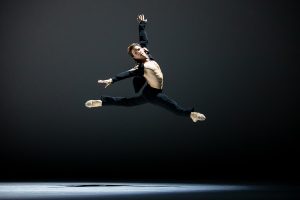

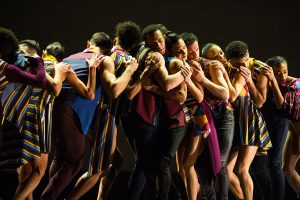



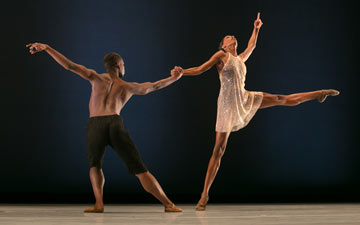
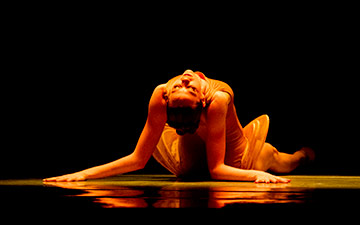
You must be logged in to post a comment.